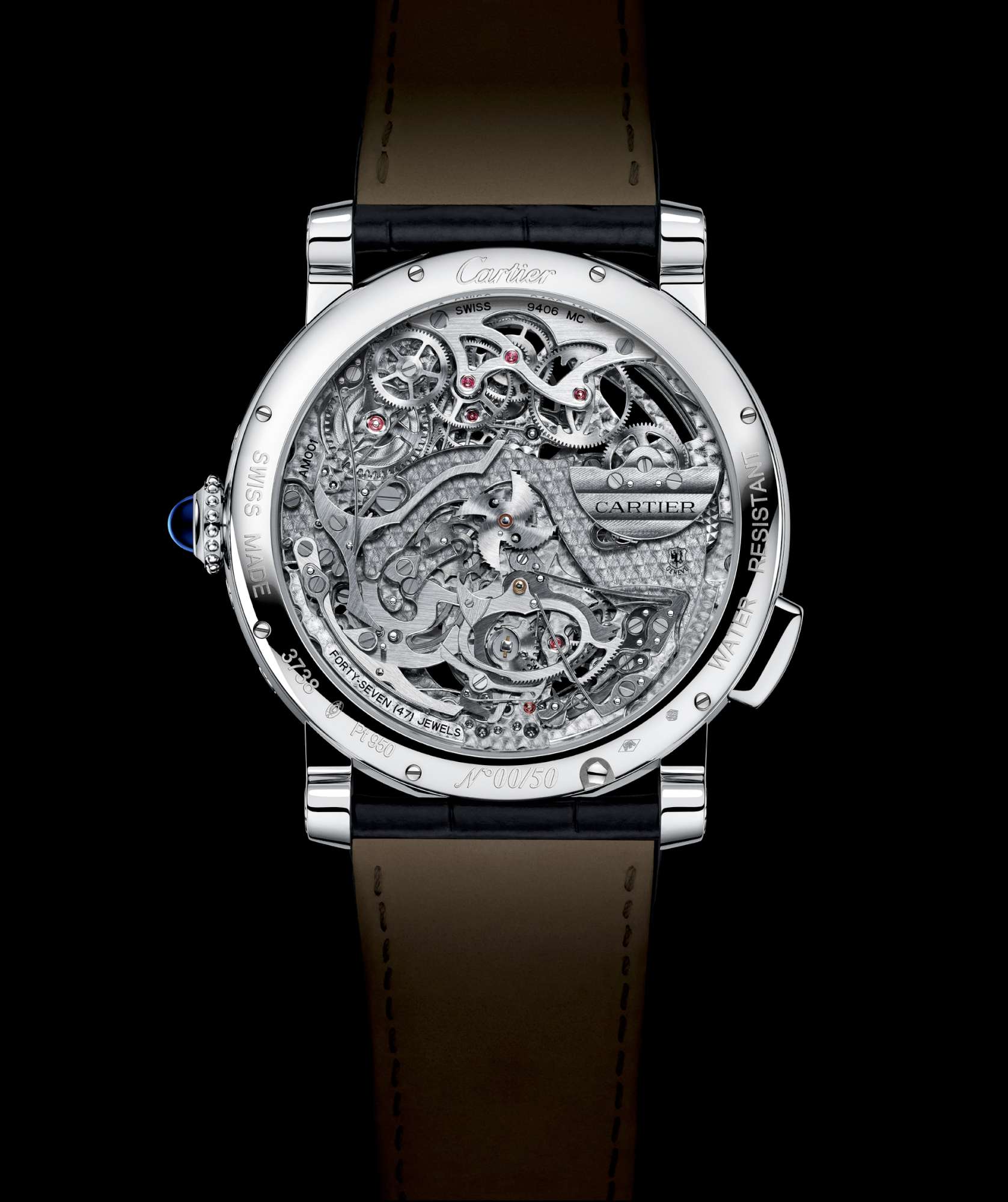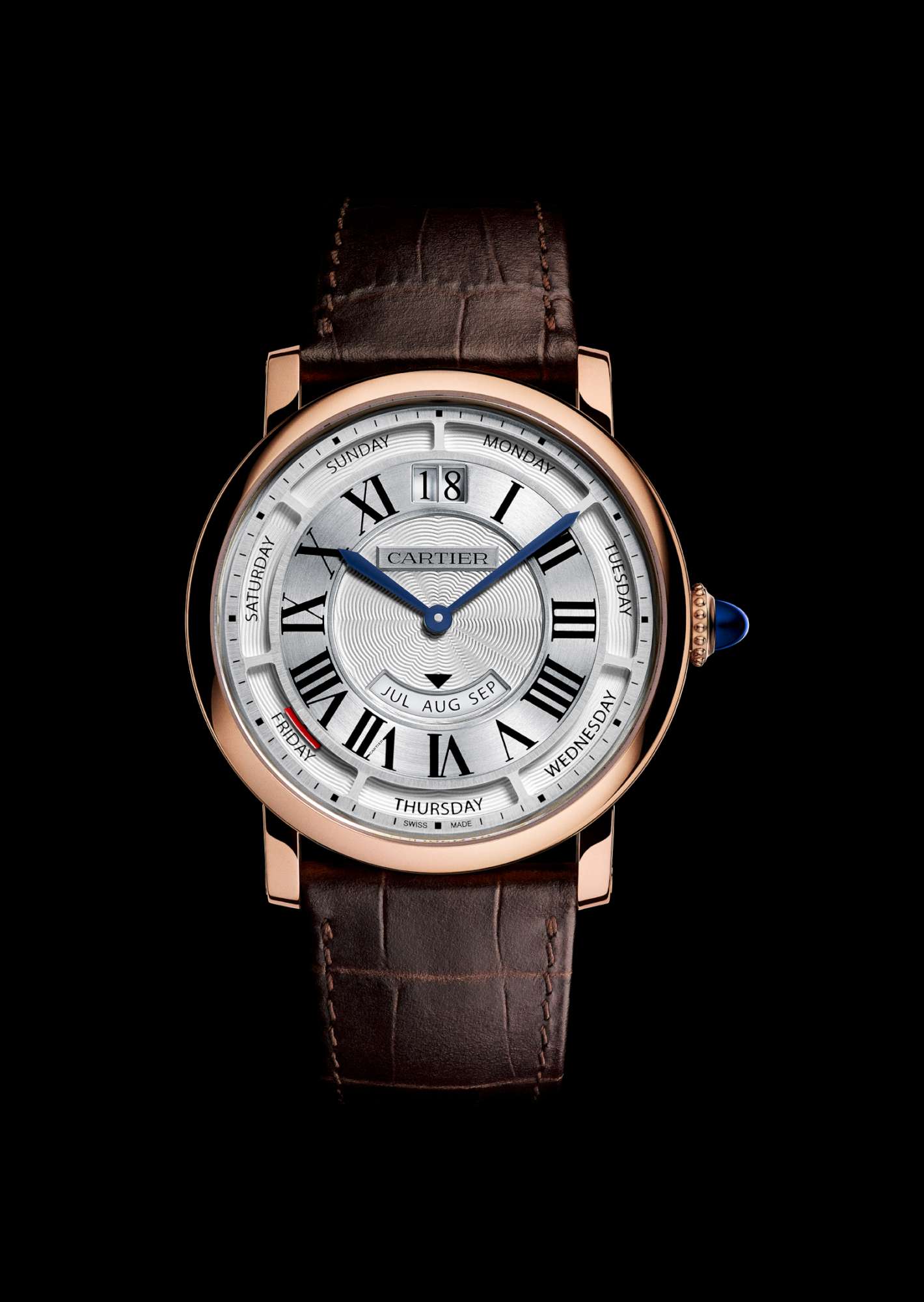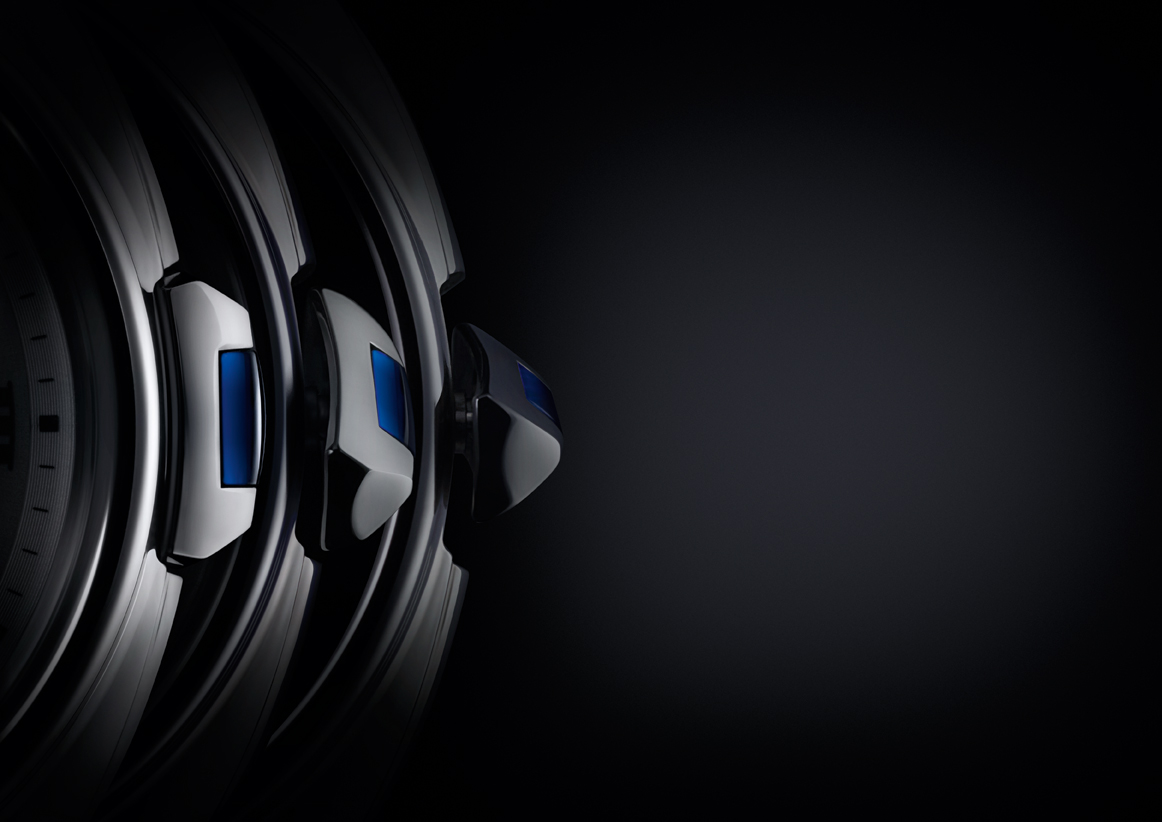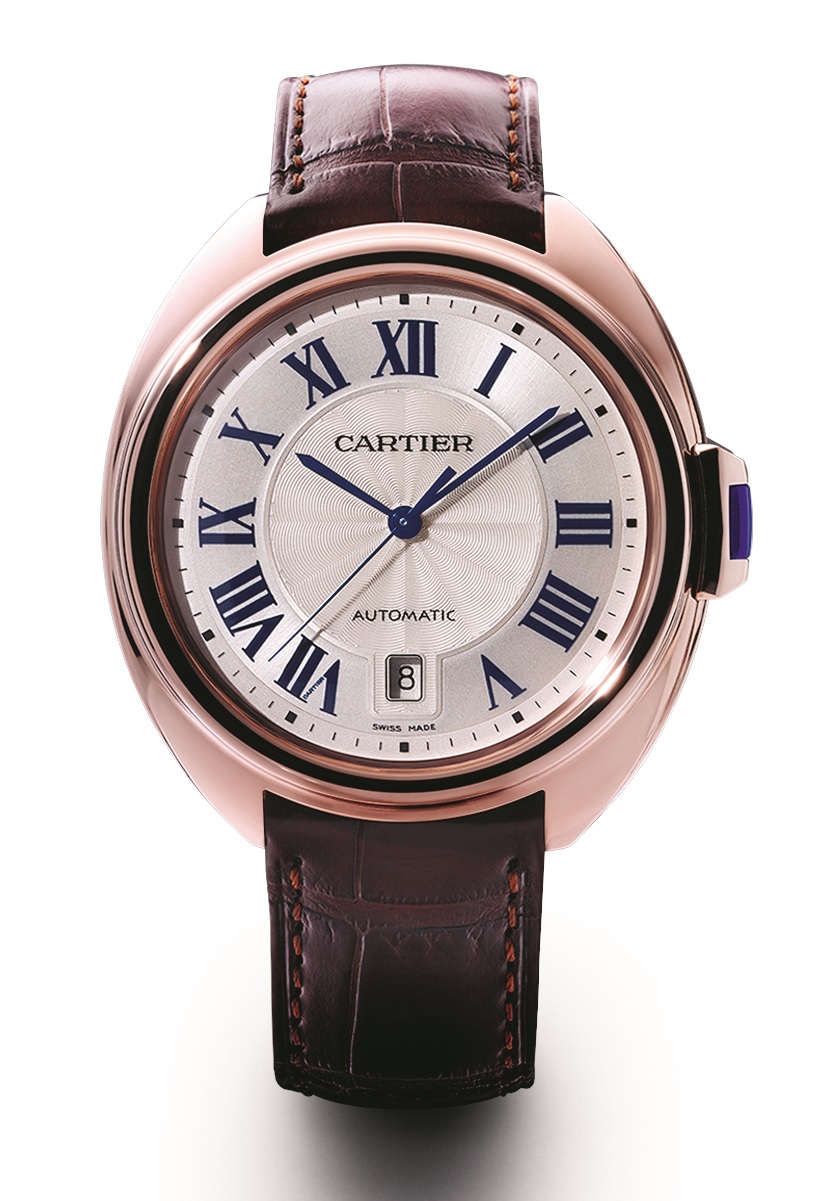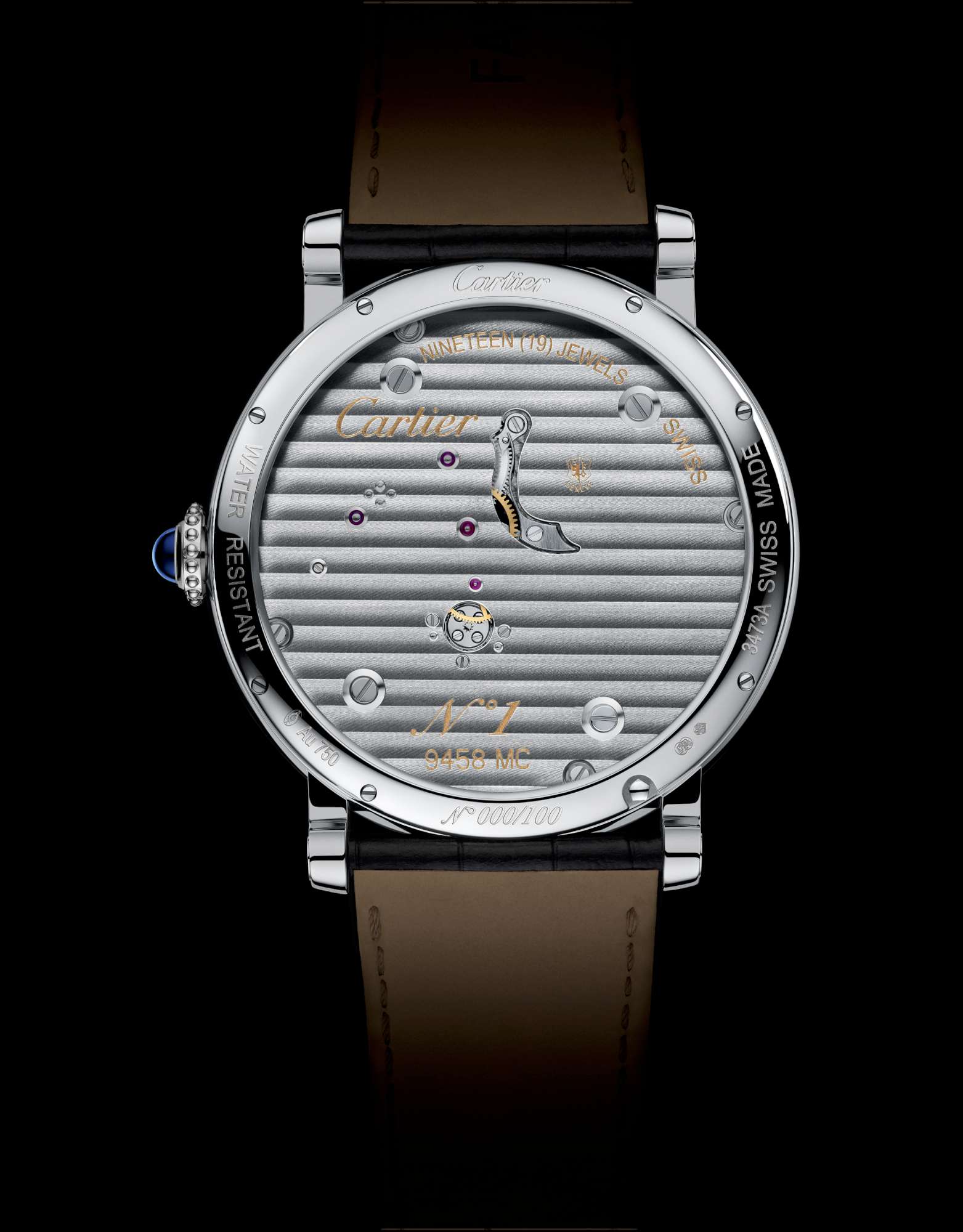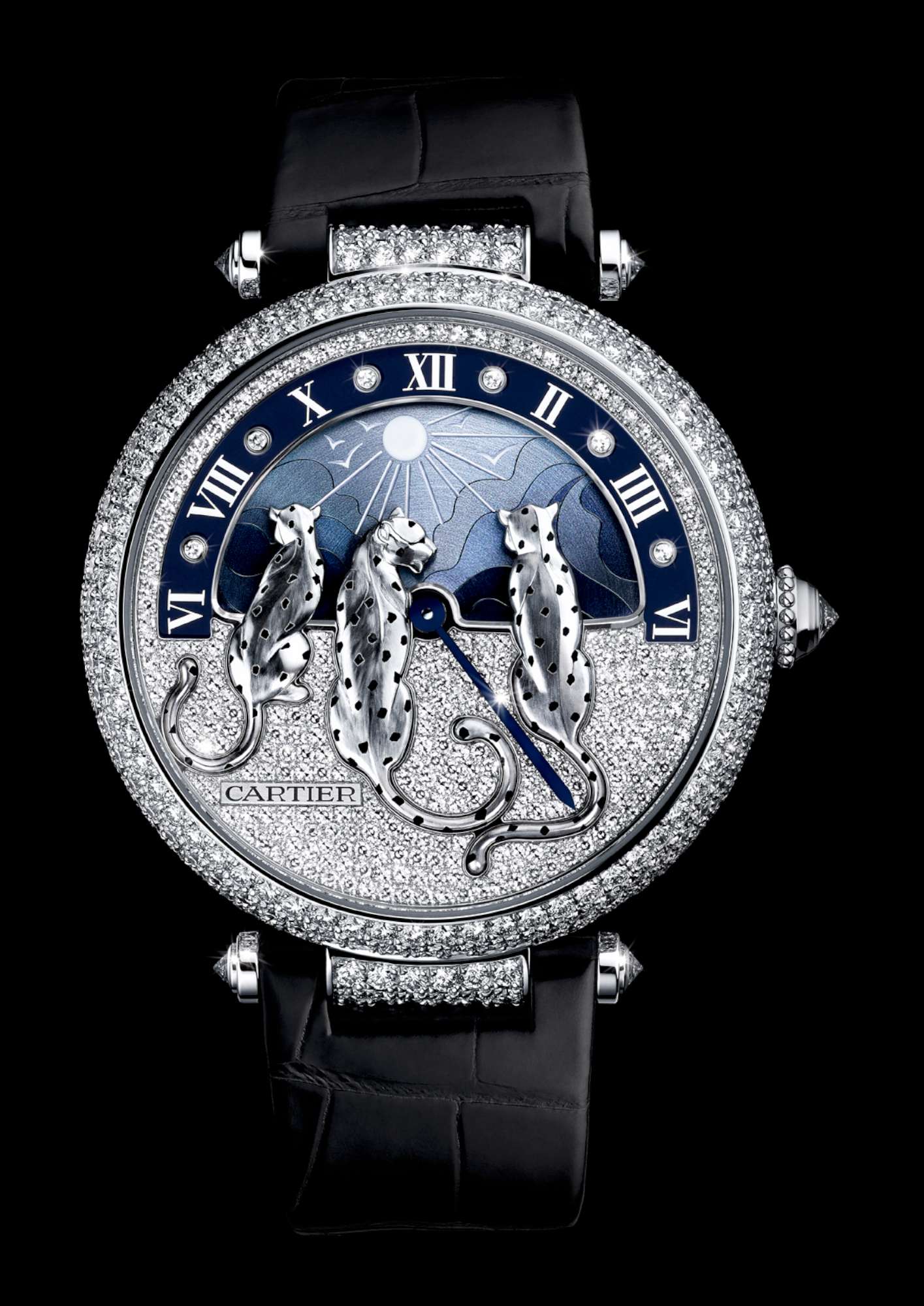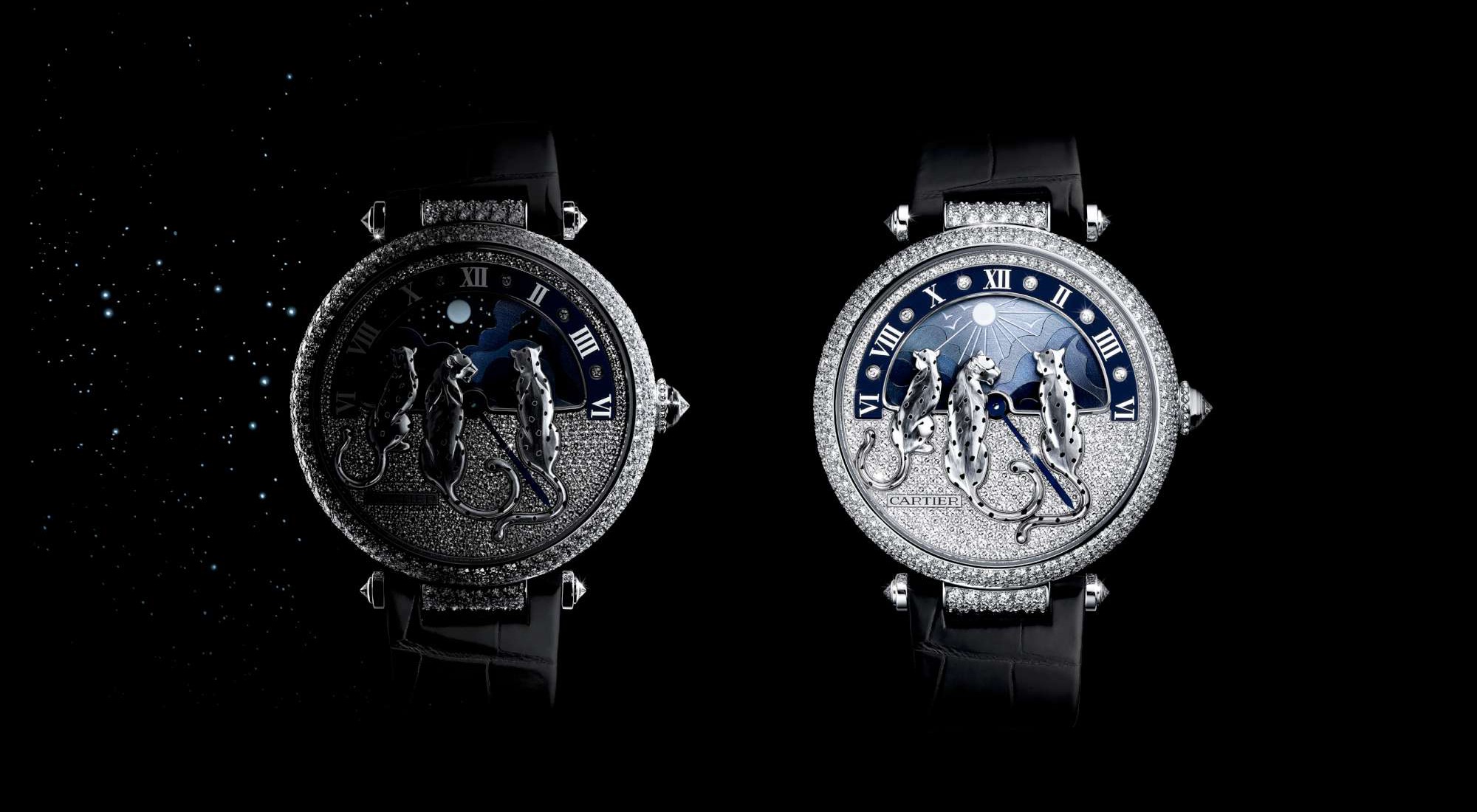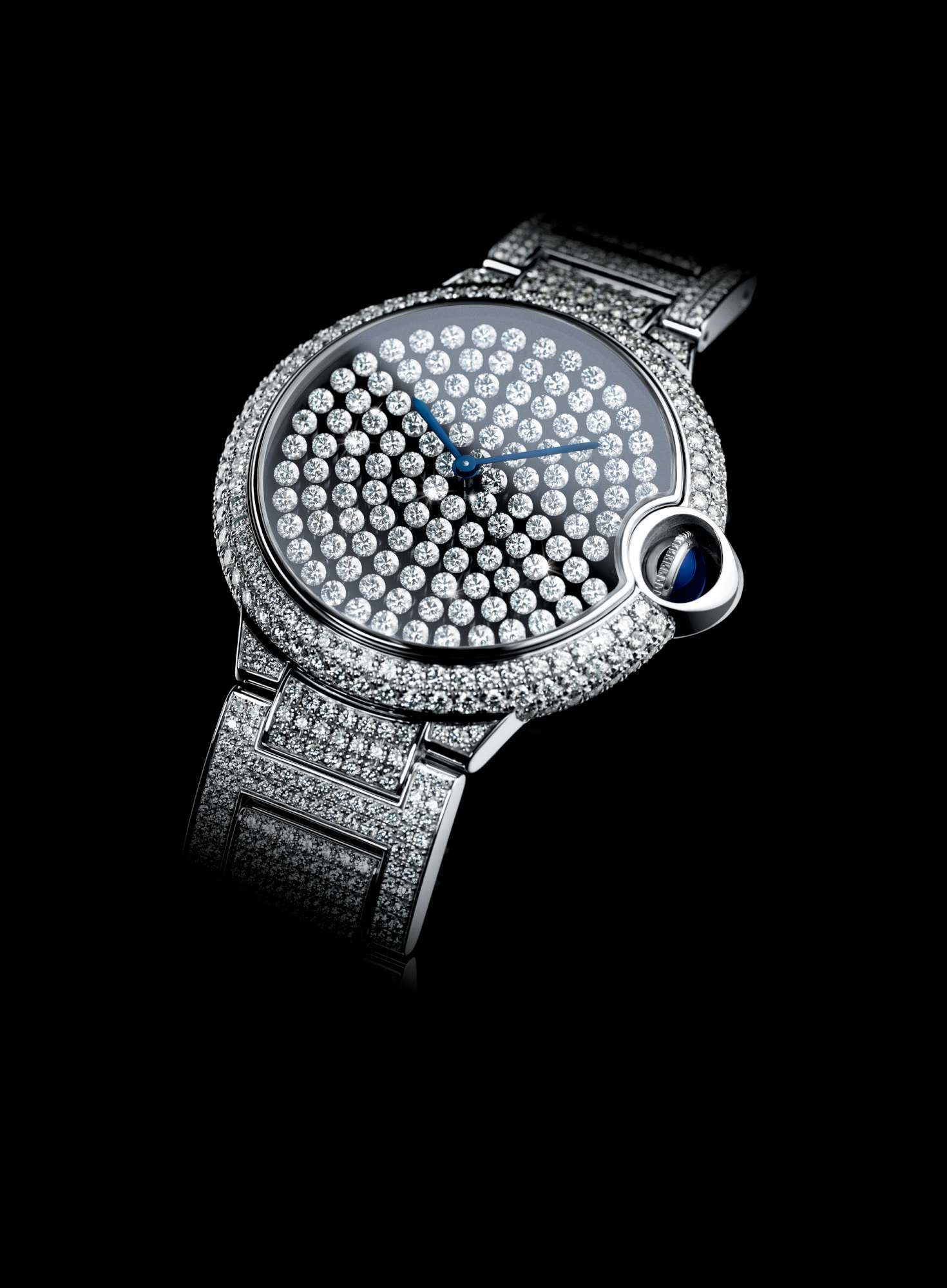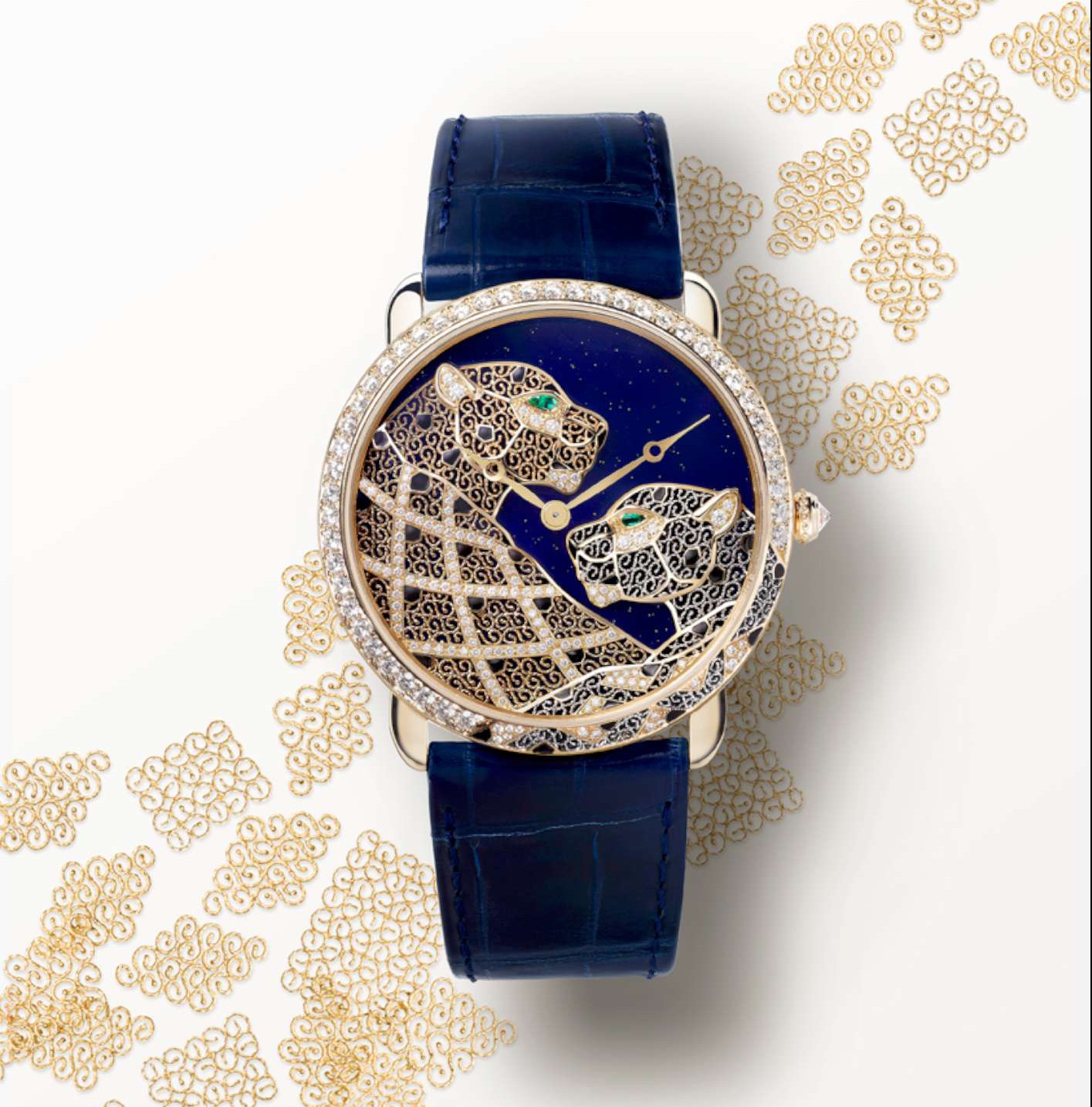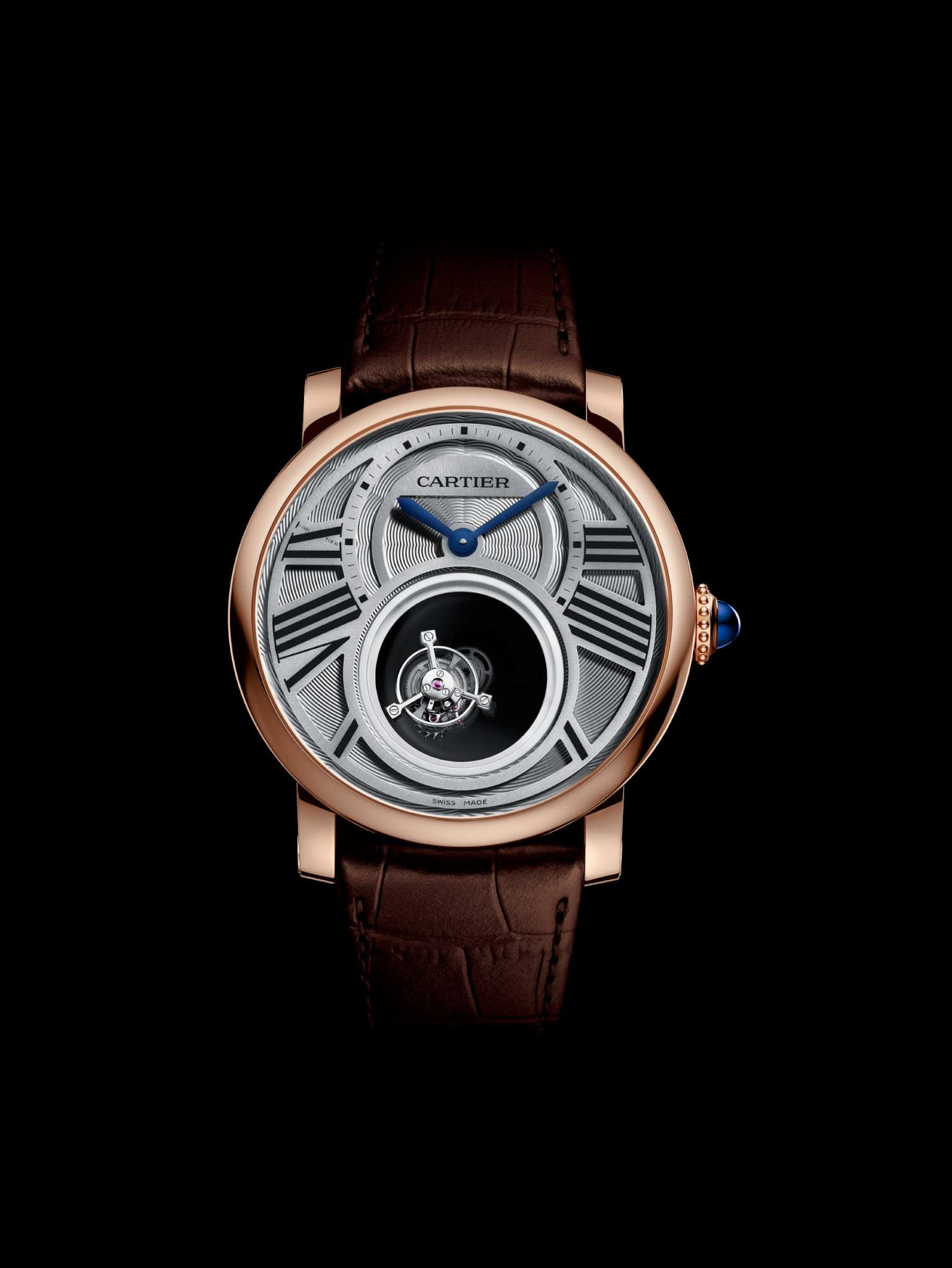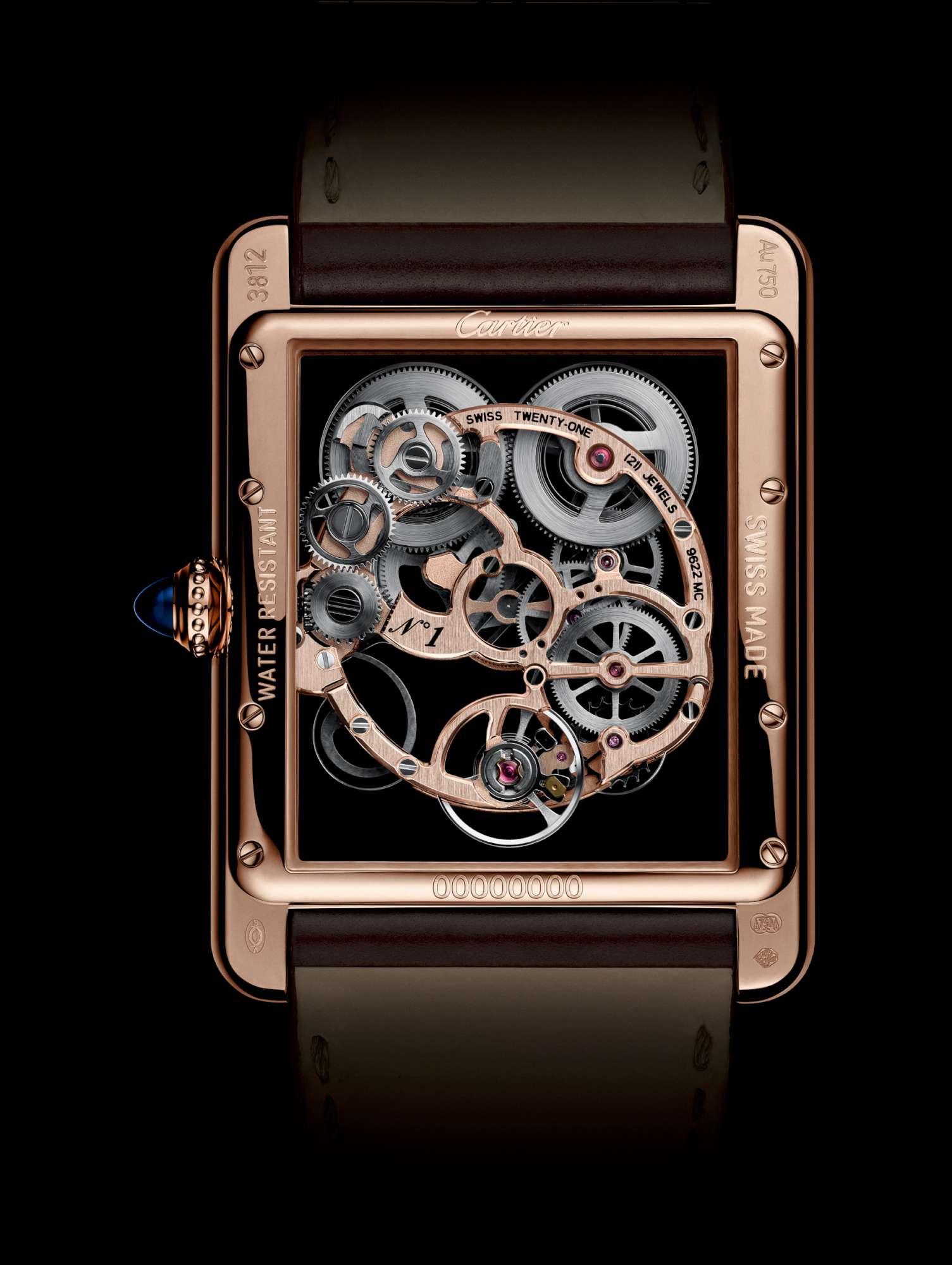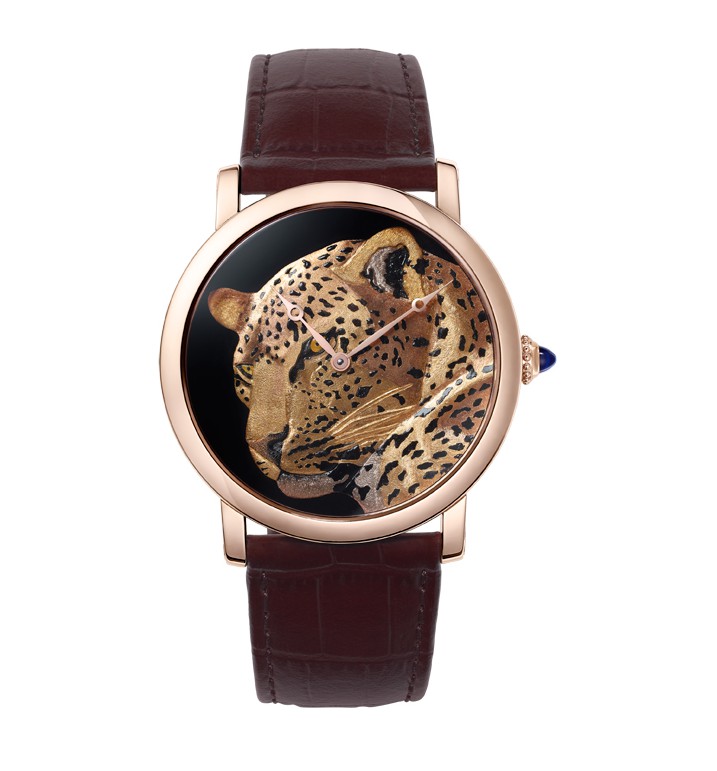Just the fact that it’s possible to write a top ten article about Cartier’s new watches presented at SIHH is remarkable. In actual fact, if you include all the variants, dial colours and so forth, the total would come to over a hundred. Admittedly a few of them are existing models that have simply been released in new case materials, but even so, the new pieces reveal an impressive breadth of invention. Let’s have a look at the top 10.
1. Rotonde de Cartier Grand Complication
The most complex timepiece ever by Cartier, this combines a perpetual calendar, tourbillon and minute repeater into a movement with 578 components, and a self-winding movement – the Calibre 9406 MC – with a thickness of just 5.49 mm. The watch took 5 years to develop, and just assembling it requires five weeks work by a master watchmaker.
The minute repeater is in full view, with two gongs and hammers, and the inertia fly wheel to the left of the months subdial. The Cartier designers worked a lot on the acoustics, and they say that the result is a clear and pleasant sound notwithstanding the sealed platinum case (usually, lighter metals such as titanium are used to increase the perceived volume of a minute repeater chime) with water-resistance rated at 30 metres. I have to admit that I didn’t get the chance to hear this watch.
The perpetual calendar takes account of the leap year cycle, except for the correction that will have to be made in 2100, when what would normally be a leap year will in fact only have 28 days in February.
The openwork dial is spectacular, in white gold, revealing parts of the movement below. On the back, the micro-rotor is built to operate at a low winding speed with reduced energy loss, and it is really very small, so that you can feast your eyes on the movement details. Power reserve about 50 hours. The case is 45 mm in diameter, 12.6 mm thick, with the usual crown set with a blue sapphire cabochon. A limited edition of 50 pieces.
2. Rotonde de Cartier Annual Calendar
The Rotonde de Cartier Annual Calendar presents the information typical of annual calendar watches – day, date, month – in a new way. Just inside the minute chapter ring, a series of seven windows have the days of the week spelled out in full, with a red hammer-shaped hand positioned so that only the tip of the head can be seen. It jumps at midnight to indicate the new day. There is a big date in the 12 o’clock position, and a rotating disc for the months at 6 o’clock. The movement keeps track of the differing lengths of the months, but requires adjustment once a year for the change from 28 or 29 February to 1 March. As a watch like this will probably spend quite a lot of its time in a safe, ease of setting and adjustment is important, and in fact all information can be adjusted from the crown.
The typically Cartier design features are the crown set with a cabochon blue sapphire, the attractive heavy black Roman numerals (there is a secret signature on the VII numeral) and the guilloché design at the centre. I particularly like the way that the Roman numerals are perfectly regular and radial in the top half of the dial, while in the lower half they slope differently, adding complexity and individuality.
The Calibre 9908 MC movement is automatic, with 291 components, and a power reserve of about 48 hours. The case is 40 mm in diameter, and the watch is made in two versions, pink gold, and a more contemporary version in white gold with grey dial. Price of the order of €30,000 for the white gold version, €27,500 for the pink gold.
3. Cartier Clé de Cartier
In its history, Cartier has created several case shapes that have become icons, such as the square watch that the brand made for aviator Santos-Dumont (one of the very first wristwatches), the rectangular Tank, the crazy squashed Crash, and the circular Ballon Bleu. Clé de Cartier has a new shape, with a circular bezel developing from a cushion-like case, and a curved, arching profile when seen from the side, following the wrist’s natural curve. This case shape includes an important new technical feature. the “Clé,” in this case the crown, which is rectangular and not circular. So you don’t have to fight with it using fingernails to pull it out. You just have to rotate it, which brings its extremities outside the thickness of the watchcase and so it’s easy to pull out, after which you can adjust time and date as normal. Once you’re done, just push back in and then rotate to the final position. The processes are accompanied by gentle clicks that provide an audible clue as to what you are doing.
Inside the watch, the new in-house movement, Calibre 1847 MC, was named after the year of the brand’s foundation, and its innovative features include a relatively fast-moving barrel for improved precision, a dual-direction winding mechanism, and 42-hour power reserve. As well as the basic time functions, the watch has a semi-instantaneous date indicator. The movement is beautifully finished with wavy Côtes de Genève. The watch is made in a men’s 40-mm case size, and 35 or 31 mm for women.
4. Cartier Crash Skeleton
The deliciously curving, Dalì-esque soft watch shape of the Crash was invented in 1967, and the story goes that a customer brought a damaged Cartier watch to the London branch. The head of the branch was fascinated by the curves of the wrecked case and thought it would look good as an original new design. Its mood fitted the joyous atmosphere of swinging London and over the next decade, by means of some very limited editions, it became a collector’s piece.
The Crash Skeleton is deliciously quirky, and the only regular things about it are the central position of the hands, and the crown that provides an important visual reference for telling the time. The openwork dial is based on Roman numerals, but these are just vaguely suggested and incomplete. Not only is the case curved from the top, it is also arched in profile, and the Calibre 9618 manually-wound movement is specially designed to fit into this complex curved shape. Power reserve is about 72 hours (3 days). The platinum case is about 28 mm wide and 45 mm from top to bottom, 9.62 mm thick.
5. Rotonde de Cartier Astrotourbillon
The Rotonde de Cartier Astrotourbillon is a watch that was presented in 2010, with the in-house Calibre 9451 MC movement in which the tourbillon has an elongated carriage that enables the balance to rotate around the dial, once a minute. The balance bridge is in the form of an arrow and so becomes a seconds hand. It is different from a normal tourbillon in which the two axes of rotation are close together and combined into a single unit, but the technical function of neutralizing the detrimental effect of gravity on the movement’s precision by constantly altering the position of the balance wheel axis remains the same. And it’s even more spectacular, with the constant rotation of the balance around the dial. It is conceptually similar to the Freak by Ulysse Nardin, but in this case, the balance becomes the minute hand and so rotates around the dial once an hour. Less theatrical.
In this skeletonized version of the Rotonde de Cartier Astrotourbillon, the movement is suspended from the giant XII and VI numerals, and displayed by the sapphire crystal glasses on front and back of the watch. The only other link between the movement and the case is the bar at 3 o’clock bearing the Cartier logo that conceals the pin from the crown. The movement, in this case Calibre 9461 MC, is in German silver, with titanium used for the circular bridges on the back of the movement. Along with the white gold of the case, the result is an intriguing composition of silvery colours.
The Rotonde de Cartier Astrotourbillon Skeleton has a 47-mm case in white gold, 15.5 mm thick, and a crown set with a sapphire cabochon. The manually-wound movement, Calibre 9461 MC, has a power reserve of about 48 hours. The watch is a limited edition of 100 units in white gold, price about €120,000 plus tax. Another 20 pieces will be in platinum with diamonds on bezel and case, and another five with case and bracelet in platinum completely set with diamonds.
6. Rotonde de Cartier Reversed Tourbillon
The principal feature of the Rotonde de Cartier Reversed Tourbillon is the deeply-cut guilloché work on the white gold dial, something that bears comparison with Richard Mille. The previous version of this watch, presented in 2012, had a similar design, but with large stylized Roman numerals instead of the guilloché. In this new piece, the dial is again asymmetric, with the guilloché not centred but radiating from the tourbillon, where the large C on the tourbillon bridge rotates and marks the seconds on a half-scale. The hour and minute hands are also off-centred, and the minutes scale and hour markers on the inside of the bezel are calibrated to match. So, for example, the 12 o’clock marker is right of centre, and the minute scale is wider on the left-hand side of the dial than the right.
In this movement, parts of the top plate have been eliminated so that we can see more than just the tourbillon. Above the pivot for the hour and minute hands is the barrel, with the spring visible, and just below this are the wheels of the gear train. The result is an open architecture with more depth than appears in the photographs.
When you turn it over, you see through a sapphire caseback, but the view is principally of the Côtes de Genève stripes on the baseplate. The movement is the Cartier Calibre 9458 MC, with 167 components: it is manually-wound, with a power reserve of 52 hours. The case is 46 mm in diameter, 12.73 mm thicjk, in white gold. The price of the new Rotonde de Cartier Reversed Tourbillon will be just over €100,000.
7. Rèves de Panthères Day/Night Complication
This fully diamond-set watch is relatively large for a women’s timepiece, 42 mm. The panther has been an important symbol for Cartier for over a century, an animal with natural elegance, both predatory and beautiful, restrained but always ready to attack. It dates back to 1914, when Louis Cartier (grandson of founder Louis-François Cartier) commissioned a drawing of a woman with jewels and a panther from French painter George Barbier, an image that was used in the company’s advertising. Later in 1914, the first Cartier panther product appeared, a wristwatch paved in precious stones, amongst which there were some black speckles representing the panther’s fur. In 1917, Louis Cartier gave a panther-inspired cigarette case to his friend Jeanne Toussaint, and the year after, she joined the company as designer, and soon began creating panther pieces herself. She was a bold and elegant woman and so it was only natural that she herself became nicknamed “La Panthère.” With her creative input, Cartier continued to produce panther pieces, the first panther ring appearing in 1935, and the first three-dimensional panther made in 1948, an emerald brooch for the Duchess of Windsor. In this watch there are three panthers, and they look over the horizon to the sky, which rotates once every 24 hours. The sun or moon on the rotating dial shows the time in hours, while the minute hand at the centre of the dial gives an indication of the minutes. The watch is powered by the Calibre 9916 MC movement, with power reserve of about 48 hours.
8. Ballon Bleu de Cartier 42 mm Serti Vibrant
This is a watch that you can only appreciate from a video. The vibrating setting (Serti Vibrant) is a technique of setting diamonds that enables them to vibrate when the watch moves, giving them a spectacular flickering brilliance. In this piece it is enhanced by the NAC-treated white gold dial (NAC is a surface treatment that electroplates a grey-black alloy of platinum and similar related metals onto a metal susbstrate). The case and bracelet are also entirely diamond-set, and the only touches of colour are the sapphire cabochon and the blued steel hands. The watch is powered by the Calibre 430 MC manually-wound movement, but the diamonds on the dial will carry on moving as long as the wearer does. A limited edition of 20 numbered pieces. Case diameter 42 mm, thickness 14.05 mm.
9. Ronde Louis Cartier Filigree watch
The panther returns in this new watch in which the ancient art of filigree – invented by the Sumerians in about 3000 B.C. and continued in Ancient Egypt, India, Tibet, Greece, Iran, and much later in Portugal – is taken to new levels, using gold and platinum micro-wires that are shaped into tiny rings and then assembled to create the lacy sheets that recreate the panther’s fur, with spots in black lacquer. The dial is in deep blue enamel with golden stars. The movement is the manual 430 MC, the case is 42 mm in diameter and 8 mm thick.
10. Rotonde de Cartier Mysterious Double Tourbillon
Cartier has a long history of mystery clocks, with hands that seem to float in mid-air. In the Rotonde de Cartier Mysterious Double Tourbillon, it is the tourbillon that is suspended, rotating once around its own axis every 60 seconds, and the whole tourbillon cage rotating once in five minutes around the circular aperture. The illusion is achieved by mounting the tourbillon cage onto a sapphire disc that has a toothed outer edge, so that the disc itself becomes a gear wheel performing one revolution every 5 minutes. This watch was originally presented in 2013: I would guess that this year’s piece is simply a version with a new case material, pink gold. The movement is the same as in 2013, the manually-wound Calibre 9454 MC, providing about 52 hours power reserve. The case is 45 mm in diameter.
11. Tank Louis Cartier Skeleton Sapphire
This watch was originally presented in 2014: this year’s version has a pink gold case and bridge. The sapphire mounting plate produces an effect of the movement floating in space, with everything suspended from the circular bridge. The movement is very visible throughout, with the two barrels at the top providing about 72 hours power reserve. The watch is small and thin enough to be a dress watch, 30 x 39.2 mm, 7.45 mm thick. The Calibre 9622 MC movement has 159 components.
12. Rotonde de Cartier with damascened panther
This beautiful piece features a very realistic panther in damascened yellow, pink and white gold, with lacquer spots and nose, on a black onyx dial. Calibre 9601 manually-wound movement, 42 mm case, limited edition of 50 pieces.

